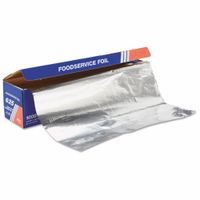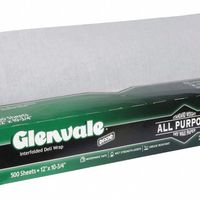Call +(254) 703 030 000 / 751 483 999 / 721 704 777
- Home
- Furnishings Appliances Hospitality
- Breakroom Food Service Disposables
- Disposable Food Wrap Dispensers Safety Labeling
- Disposable Food Wraps Liners Dispensers
.....Read More
Frequently Asked Questions
What is the best material to keep food warm for long periods?
The best material to keep food warm for long periods is typically a combination of stainless steel and insulation materials like foam or vacuum insulation. Stainless steel is highly effective due to its durability, non-reactive nature, and ability to conduct heat evenly. When used in conjunction with vacuum insulation, it creates a barrier that minimizes heat transfer, maintaining the food's temperature for extended periods.
Vacuum insulation is particularly effective because it removes air from the space between two layers of stainless steel, significantly reducing heat loss through conduction and convection. This technology is commonly used in thermos flasks and insulated food containers, which are designed to keep food warm for several hours.
Foam insulation, often made from materials like polyurethane, is another option. It works by trapping air in small pockets, which slows down the transfer of heat. While not as effective as vacuum insulation, it is still a good choice for less demanding applications.
In addition to the material, the design of the container also plays a crucial role. Containers with tight-fitting lids and minimal air gaps will perform better in retaining heat. Double-walled construction is another feature that enhances thermal retention by providing an additional layer of insulation.
Overall, for optimal performance in keeping food warm, a container made of stainless steel with vacuum insulation is the best choice. It combines the strengths of both materials, offering durability, safety, and superior heat retention.
How does aluminum foil insulate cooked food?
Aluminum foil insulates cooked food primarily through its reflective and barrier properties. When food is cooked and wrapped in aluminum foil, the foil acts as a barrier to air and moisture, which helps retain heat. The reflective surface of the foil reflects thermal radiation back towards the food, reducing heat loss. This reflection of heat helps maintain the temperature of the food for a longer period.
Additionally, aluminum foil is a poor conductor of heat compared to other metals, which means it does not easily transfer heat away from the food. This property helps in minimizing heat loss through conduction. The foil also creates a sealed environment around the food, trapping steam and moisture. This trapped steam can help keep the food warm and moist, preventing it from drying out.
Moreover, the thinness of the foil allows it to conform closely to the shape of the food, minimizing air pockets that could facilitate heat loss through convection. By reducing the movement of air around the food, the foil further insulates the food, maintaining its temperature.
In summary, aluminum foil insulates cooked food by reflecting heat back towards the food, acting as a barrier to air and moisture, and minimizing heat loss through conduction and convection. These combined properties help keep the food warm and maintain its quality after cooking.
Can plastic film wrap be used to keep food warm?
Plastic film wrap is not ideal for keeping food warm. It is primarily designed to cover and protect food from contaminants and moisture, rather than to insulate or retain heat. Plastic wrap is thin and does not have the thermal properties necessary to maintain food temperature effectively. When exposed to heat, some plastic wraps can melt or release harmful chemicals, especially if they are not labeled as microwave-safe. For keeping food warm, materials like aluminum foil, which has better insulating properties, or thermal containers are more suitable.
What are the benefits of using food paper wraps?
Food paper wraps offer several benefits:
1. **Sustainability**: Made from renewable resources, they are biodegradable and compostable, reducing environmental impact compared to plastic wraps.
2. **Breathability**: They allow food to breathe, preventing moisture buildup and keeping items like sandwiches and pastries fresh without becoming soggy.
3. **Versatility**: Suitable for wrapping a variety of foods, from sandwiches to baked goods, and can be used in different settings, including restaurants, picnics, and home kitchens.
4. **Customizability**: Available in various sizes, designs, and prints, they can be customized for branding purposes, enhancing the presentation and appeal of food products.
5. **Non-toxic**: Free from harmful chemicals often found in plastic wraps, they are safe for direct contact with food, ensuring consumer health and safety.
6. **Insulation**: Some food paper wraps have insulating properties, helping to maintain the temperature of hot or cold foods for longer periods.
7. **Cost-effective**: Generally more affordable than some alternatives, especially when purchased in bulk, making them a cost-effective option for businesses.
8. **Convenience**: Easy to use and dispose of, they simplify the packaging process and reduce cleanup time.
9. **Aesthetic Appeal**: Enhances the visual appeal of food items, making them more attractive to consumers and potentially increasing sales.
10. **Regulatory Compliance**: Often meet food safety standards and regulations, ensuring compliance for businesses in the food industry.
Overall, food paper wraps provide an eco-friendly, practical, and aesthetically pleasing solution for food packaging needs.
How do pan liners reduce clean-up time?
Pan liners reduce clean-up time by creating a barrier between the food and the pan, preventing food from sticking to the surface. This means that after cooking, the food can be easily removed without leaving residues that typically require scrubbing. The liner catches any drips, spills, or grease, which would otherwise bake onto the pan and become difficult to clean.
Since the liner is disposable, it can be simply lifted out and discarded, leaving the pan underneath virtually clean. This eliminates the need for soaking or using abrasive cleaning tools, which can be time-consuming. Additionally, pan liners help in maintaining the condition of the cookware by reducing wear and tear from frequent scrubbing, thus extending the life of the pans.
For commercial kitchens or large-scale cooking, using pan liners can significantly cut down on labor costs and time spent on cleaning, allowing staff to focus on other tasks. In home kitchens, they offer convenience and ease, especially after preparing meals that typically result in stubborn residues. Overall, pan liners streamline the cleaning process, making it quicker and more efficient.
Is aluminum foil better than plastic wrap for food storage?
Aluminum foil and plastic wrap each have their advantages and disadvantages when it comes to food storage, and their effectiveness depends on the specific use case.
Aluminum foil is excellent for wrapping foods that need to be protected from light, moisture, and air. It is particularly useful for covering dishes in the oven or on the grill, as it can withstand high temperatures. Foil is also ideal for wrapping foods that have strong odors, as it provides a better barrier than plastic wrap. However, it is not suitable for use with acidic foods, as it can react with them and alter the taste.
Plastic wrap, on the other hand, is more versatile for everyday food storage. It clings tightly to containers and food items, creating a seal that helps keep food fresh. It is particularly useful for storing items in the refrigerator or freezer, as it prevents freezer burn and keeps moisture in. Plastic wrap is also transparent, making it easy to see the contents without unwrapping. However, it is not heat-resistant and should not be used in the oven or on the grill.
In terms of environmental impact, aluminum foil is recyclable, but only if it is clean and free of food residue. Plastic wrap is generally not recyclable and contributes to plastic waste.
Ultimately, the choice between aluminum foil and plastic wrap depends on the specific needs of the food storage situation. For high-temperature cooking and odor protection, aluminum foil is preferable. For general storage and ease of use, plastic wrap is often more convenient.
What are the differences between aluminum foil, plastic wrap, and food paper wraps?
Aluminum foil, plastic wrap, and food paper wraps differ in material composition, usage, and properties.
Aluminum foil is made from thin sheets of aluminum and is known for its durability and heat resistance. It is ideal for cooking, grilling, and baking, as it can withstand high temperatures and is excellent for wrapping foods to retain moisture and flavor. It also provides a strong barrier against light, oxygen, and moisture, making it suitable for long-term food storage.
Plastic wrap, or cling film, is made from polyvinyl chloride (PVC) or low-density polyethylene (LDPE). It is flexible, transparent, and clings to surfaces, making it useful for covering containers and wrapping food items to prevent air exposure and contamination. However, it is not heat-resistant and should not be used in high-temperature applications like baking or grilling.
Food paper wraps, such as wax paper, parchment paper, and butcher paper, are made from paper treated with various coatings. Wax paper is coated with paraffin or soybean wax, making it moisture-resistant but not heat-resistant. It is suitable for wrapping foods for short-term storage and lining surfaces for non-stick purposes. Parchment paper is coated with silicone, providing heat resistance and non-stick properties, ideal for baking. Butcher paper is uncoated, breathable, and used for wrapping meats to allow them to age without spoiling.
In summary, aluminum foil is best for high-heat applications and long-term storage, plastic wrap is ideal for short-term coverage and freshness, and food paper wraps serve specific purposes based on their coatings and properties.

